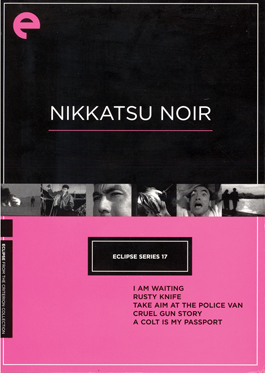home | metro silicon valley index | movies | current reviews | dvd review

Eastern Noir
A new set from Criterion shows off some action-packed Japanese crime dramas
By Michael S. Gant
IN THE LATE '50s, Nikkatsu, Japan's oldest film studio, jolted audiences with punchy, brash, hip-looking gangster films that borrowed equally from American film noir and French existential crime dramas. This set from Criterion contains five prime examples that illustrate a progression from kitchen-sink noir to increasingly baroque urban shoot-'em-ups. They are all in black-and-white, boast propulsive, Western-jazz soundtracks and rely heavily on familiar underworld visual tropes like pork-pie hats, trench coats and rain-soaked alleys.In both I Am Waiting (1957) and Rusty Knife (1958), Yujiro Ishihara plays a tough guy trying to escape a brutal past, but they keep pulling him back in.
I Am Waiting takes place in a small waterfront diner where Ishihara's character takes pity on a lonely, desperate girl (Mie Kitahara) who has run away from some petty mobsters who force her to work as a ... chanteuse. The setup and the slowly dawning romantic dynamic borrows a lot from Moontide with Jean Gabin and Ida Lupino. Ishihara plays an ex-hood in Rusty Knife. He witnessed a murder and must negotiate between the perpetrators and the police—a task complicated by the seductive daughter (Kitahara again) of the victim.Take Aim at the Police Van (1960) starts to veer off into Sam Fuller territory with the story of a prison guard who loses his job in the wake of an ambush and sets out to avenge the crime. The plot defies parsing, and some of the characters' motivations gyrate wildly as Mr. Tamon (Michitaro Mizushima) uncovers a slave-ring/smuggling operation. How a half-naked geisha ends up skewered with an arrow shot through a paper curtain is never explained—but really, would it make any difference? The film scoots along and climaxes with a great night-time showdown in a rail yard full of steam trains.
Joe Shishido stars in Cruel Gun Story (1964), which cranks up the level of self-awareness to almost Bondian (or at least Mission Impossible) levels with plenty of absurd gun battles in which legions of attackers succumb while being unable to even wing our looming antihero. Shishido (Branded to Kill—the Japanese had a gift for titles, or translation) is identifiable immediately thanks to his surgically enlarged puffy cheeks (he couldn't just stuff them with cotton balls like Brando?). The result is faintly ridiculous to my eyes (just about every critic falls back on the adjective "chipmunklike"), but the change made Shishido a star.
Here he plays a very cool crook enlisted in an armed-car robbery that goes terribly wrong. With his sunglasses, slicked-back hair and intense squint, he's like Craig Stevens' Peter Gunn. Shishido manifests some deep doubts about his life of crime ("There's nothing left inside ... those bastards played me and won") and then goes out and guns down some more faceless enemies. The film boasts some nifty accoutrements—an MG convertible, a serpentine bar, a chase through a sewer—and doesn't take itself too seriously. In the best moment, Shishido, possibly gutshot, lies on the floor, his cigarette still rakishly clenched between his lips. A Colt Is My Passport (1967) again showcases Shishido in an inexplicable story of a Yakuza assassin dodging between two underworld outfits. The editing and wide-angle shots are ramped up to shock-cut level, and the film is best enjoyed as an exercise in style. This set offers a lot of high-voltage entertainment, with nothing lost in translation. No extras.
NIKKATSU NOIR: Eclipse Series 17; five discs; Criterion; $69.98.
Send a letter to the editor about this story.
|
|
|
|
|
|